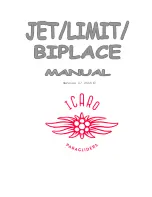
36
Section 8
Storing and looking after the paraglider
Lines
The TWIN RS has various different high-
quality and accurately manufactured lines
which have been selected according to the
load and area of use. You should also
protect the lines from unnecessary UV light
because, as with the fabric, UV light in
particular will weaken the lines.
PLEASE NOTE
Dyneema lines, which are used in the
area of the main brake lines, for example,
are very temperature-sensitive and can be
permanently damaged at temperatures
above 75° C. Therefore your glider should
never be stored in a hot car especially
during summer.
Be careful that there is no abrasion caused
to the coating on the lines by rubbing,
particularly when ground-training with
crossed risers.
Do not walk on the lines after the glider has
been spread out and watch out for
spectators or skiers who may inadvertently
go over the lines.
When you are packing up the glider, be
careful to avoid putting any unnecessary
kinks in the lines and use only the overhand
knot or bowline knots described for the brake
lines.
WARNING
It is imperative that you observe the
service intervals given in the Maintenance
and Service book. They must be complied
with.
There is a risk of the lines breaking if they
are not handled correctly or if service
intervals are missed.
Cleaning
If you do have to clean the glider, use only
lukewarm fresh water and a soft sponge. Use
a weak soap solution for stubborn stains,
and then rinse it out carefully and thoroughly.
Leave the glider to dry in a place which is
well-ventilated and in the shade.
PLEASE NOTE
Do not under any circumstances use
chemicals, brushes, rough cloths, high-
pressure cleaners or steamers to clean
the glider, as these can damage the fabric
coating and weaken it. The glider
becomes porous and loses braking
strength.
Do not under any circumstances put the
glider into the washing machine. Even if
washing powder is not used, the glider
would be badly damaged by the
mechanical action of the machine. Do not
put the canopy into a swimming pool -
chlorine will damage the fabric. If you
have no choice but to rinse the glider, e.g.
following a landing in the sea, gently wash
it down inside and out with fresh water.
Frequent rinsing accelerates the aging
process.
Dampness / Humidity
If the glider gets wet or damp, it should be
dried as soon as possible in a well-
ventilated room (but away from the sun). It
may take several days before the canopy
has dried completely because water may
collect inside the canopy.
Mould may form if the paraglider is stored
wet and the fibres may rot, particularly when
it is warm. This can make the paraglider
unsuitable for flying within a short time.
Contact with salt water
If salt water gets on the glider, before being
dried, it should immediately be thoroughly
rinsed in fresh water. It should then be dried
in a well-ventilated room (but away from the
sun).
There may be permanent damage to the
material if the glider is not thoroughly rinsed.









































